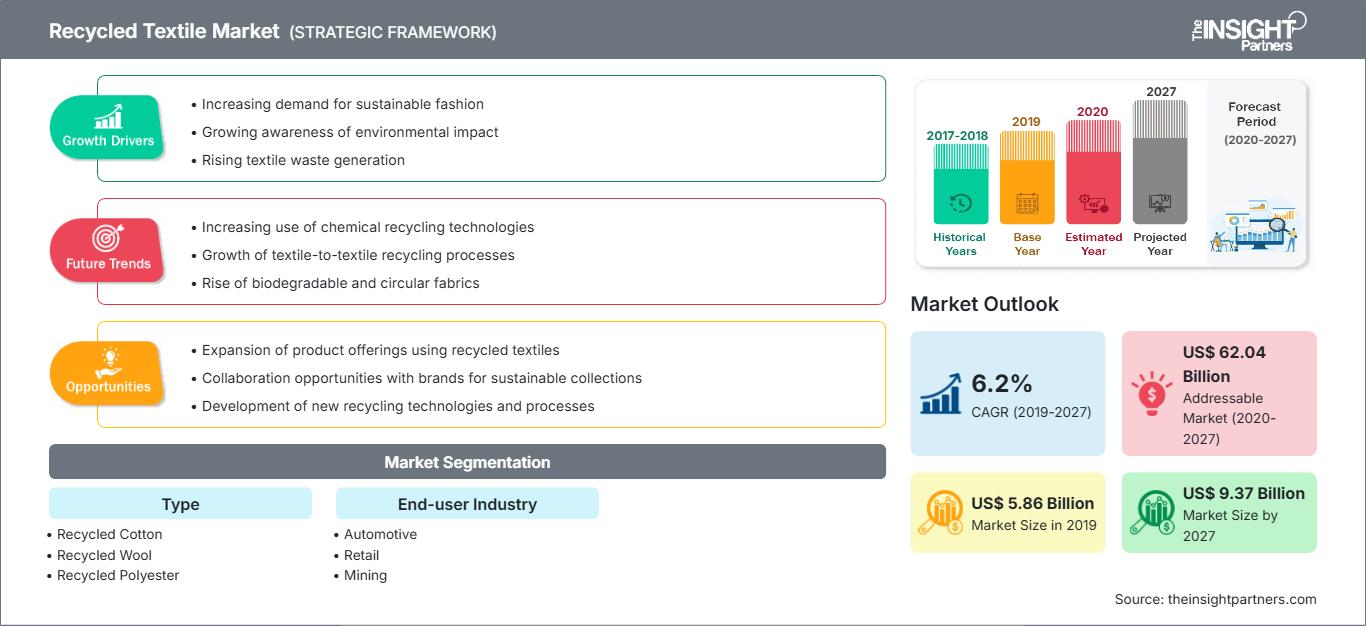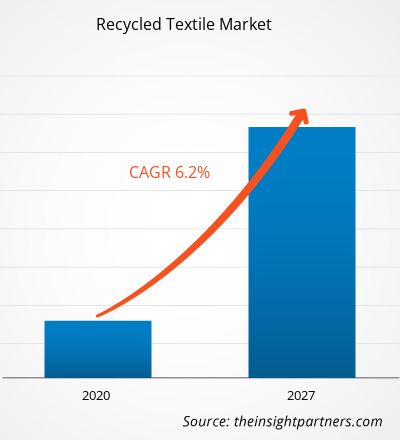リサイクル繊維市場は2019年に58億5,539万米ドルと評価され、2027年までに93億6,504万米ドルに達すると予測されています。また、2020年から2027年にかけて6.2%のCAGRで成長すると見込まれています。
リサイクル繊維とは、再利用または材料回収のために回収できる古着やその他の未使用の繊維です。近年、世界中で繊維廃棄物の処理に関する懸念が高まっており、環境に悪影響を与える可能性があります。衣類、生地、自動車など、いくつかの最終用途産業からの需要が急増しているため、リサイクル繊維の需要は世界中で高まっています。メーカーは使用済み繊維をより良い製品にリサイクルし、多様な最終用途産業で使用できるようにするために、いくつかの技術を採用しています。資源のリサイクルは、主に熱、機械、化学技術を利用して行うことができます。
ヨーロッパは、地域の政府の取り組みの増加により、リサイクル繊維の重要なリサイクル繊維市場になっています。さらに、自動車業界の間でリサイクル繊維製品の需要が高まっていることは、市場で活動するリサイクル繊維市場のプレーヤーに有利な機会を提供しています。 購買力の向上とライフスタイルの変化が、ヨーロッパ地域の繊維市場の成長を促進する主な要因の1つです。 ヨーロッパでは、消費者が使用した衣類の約15%がリサイクルされており、使用済みの衣類の75%以上がメーカーによって工業用にリサイクルされています。 ヨーロッパでのリサイクル繊維の需要は、ここ数年で最も高いペースで成長しています。 リサイクル繊維の生産者は、ドイツ、イギリスなどの国に焦点を当てており、これがヨーロッパ地域でのリサイクル繊維の大きな需要につながっています。循環型繊維経済への消費者の関心の高まりも、この地域の市場成長をさらに押し上げると予想されています。
2020年8月現在、米国、ブラジル、インド、ロシア、南アフリカ、メキシコ、スペイン、英国は、確認された症例数と報告された死亡者数で最も影響を受けている国です。COVID-19は、ロックダウン、渡航禁止、事業停止により、さまざまな国の経済と産業に影響を及ぼしています。世界の化学・素材産業は、サプライチェーンの寸断、COVID-19の発生による製造の混乱など、深刻な混乱に見舞われている主要産業の一つです。例えば、中国は世界的な製造業の中心地であり、さまざまな産業にとって最大の原材料供給国です。中国やアジア太平洋地域、ヨーロッパなどの主要地域におけるさまざまな工場のロックダウンは、世界のサプライチェーンに影響を及ぼし、さまざまな商品の製造、納期、販売に悪影響を及ぼしています。これらの要因はすべて、世界のリサイクル繊維市場に大きな影響を与えています。
要件に合わせてレポートをカスタマイズ
レポートの一部、国レベルの分析、Excelデータパックなどを含め、スタートアップ&大学向けに特別オファーや割引もご利用いただけます(無償)
リサイクル繊維市場: 戦略的洞察

- このレポートの主要な市場動向を入手してください。この無料サンプルには、市場動向から見積もりや予測に至るまでのデータ分析が含まれます。
市場洞察:繊維廃棄物の処分に関する懸念の高まり
レポートの一部、国レベルの分析、Excelデータパックなどを含め、スタートアップ&大学向けに特別オファーや割引もご利用いただけます(無償)
リサイクル繊維市場: 戦略的洞察

- このレポートの主要な市場動向を入手してください。この無料サンプルには、市場動向から見積もりや予測に至るまでのデータ分析が含まれます。
繊維製造工程は、化学薬品を大量に使用する工程の一つと考えられており、その工程全体を通して大量の繊維廃棄物が発生します。繊維廃棄物は、使用前の繊維廃棄物と使用後の繊維の2つのグループに分けられます。繊維廃棄物の増加は環境に負担をかけ、既存の埋め立て地での効率的な処分や焼却の問題を引き起こします。推定によると、未使用の繊維製品の約10~20%が廃棄されていると考えられています。例えば、米国環境保護庁(EPA)によると、2015年には合計1,575万トンの繊維が都市固形廃棄物として発生し、そのうち19%が焼却され、65%が埋め立てられました。さらに、米国環境保護庁(EPA)の報告書は、繊維の生産と処分が温室効果ガスの排出につながることを示唆しています。さらに、焼却処理では重金属、ダイオキシン、酸性ガス、粉塵などの有機物質が排出され、これらは人体と環境の両方に有害であると考えられています。また、残留灰にも高濃度の有毒物質が含まれているため、その処理も深刻な問題となっています。そのため、環境の持続可能性を促進するために、再利用またはリサイクル方法を通じて繊維廃棄物を効果的に管理することが極めて重要です。このような状況下では、繊維廃棄物のリサイクルは実行可能な代替手段と考えられており、天然資源への負担を軽減し、埋立地のスペースを最小限に抑え、エネルギーを節約するのに役立ちます。さらに、繊維廃棄物の効果的な管理を規制する厳格な政府法は、差し迫った廃棄物問題に対処するための持続可能な代替手段として、繊維リサイクルの利用を促進することを目的としている可能性があります。
タイプ別インサイト
リサイクル繊維市場は、タイプ別にリサイクル綿、リサイクルウール、リサイクルポリエステル、リサイクルナイロン、その他に分類されます。リサイクルナイロンセグメントは、2019年から2027年の予測期間中に最も高い成長率で成長すると予想されています。リサイクルナイロンは、工業用プラスチック、廃棄繊維、織物工場からの廃棄物、そして使用済みの漁網から作られています。これらはバージンナイロンと同等の品質を持つ新しいナイロンに再生されます。ナイロンバッグ、ナイロン生地、ナイロンカーペットもリサイクルナイロンに加工され、再利用されます。リサイクルナイロンの大部分は漁網由来で、海洋ゴミの削減に優れた解決策となります。ナイロンのリサイクルはナイロンに比べて費用がかかりますが、多くの環境的メリットがあります。ナイロンをリサイクルすることで、廃棄物を削減し、製造に伴う温室効果ガス排出量を削減できます。原材料としての石油への依存度を軽減できます。リサイクルナイロンの使用は、使用済みナイロン製品の新たなリサイクル方法の促進にも役立ちます。機械的にリサイクルされる材料の多くは高温で溶融され、最終的に汚染物質を破壊して再利用可能な形に変えます。一方、ナイロンはリサイクル時に低温で溶融するため、汚染物質は残ります。したがって、ナイロンはリサイクル前に丁寧に洗浄する必要があります。
エンドユーザー業界の洞察
エンドユーザー業界に基づいて、リサイクル市場は自動車、小売、鉱業、その他に分類されます。自動車セグメントは、2019年から2027年の予測期間中に最も高い成長率で成長すると予想されています。自動車業界で使用されているリサイクル繊維は、自動車部品の生産に大きく貢献しています。自動車用途におけるリサイクル繊維の使用には、床材、室内装飾品、安全ベルトなどの目に見える部品と、チューブやテープ、タイヤコード、エアバッグ部品、繊維などの目に見えないリサイクル繊維が含まれます。リサイクル繊維は、引張強度、摩耗、通気性、圧縮抵抗、弾力性、洗浄の容易さ、難燃性、動的気候条件への耐性のために自動車業界で使用されています。リサイクル綿は、座席の詰め物や自動車の断熱材に使用されます。
Anandi Enterprises、Chindi、Khaloom Textile India Pvt. Ltd.、Kishco Groupなどは、世界のリサイクル繊維市場における主要プレーヤーです。これらの企業は、顧客基盤の拡大と世界的な市場シェアの獲得を目指し、新製品開発やM&A戦略を展開しています。これにより、世界的なブランドイメージの維持が可能になっています。
リサイクル繊維市場リサイクル繊維市場
予測期間を通じてリサイクル繊維市場に影響を与える地域的な傾向と要因は、The Insight Partnersのアナリストによって徹底的に説明されています。このセクションでは、北米、ヨーロッパ、アジア太平洋、中東・アフリカ、中南米におけるリサイクル繊維市場のセグメントと地域についても説明します。
リサイクル繊維市場レポートの範囲
| レポート属性 | 詳細 |
|---|---|
| の市場規模 2019 | US$ 5.86 Billion |
| 市場規模別 2027 | US$ 9.37 Billion |
| 世界的なCAGR (2019 - 2027) | 6.2% |
| 過去データ | 2017-2018 |
| 予測期間 | 2020-2027 |
| 対象セグメント |
By タイプ
|
| 対象地域と国 | 北米
|
| 市場リーダーと主要企業の概要 |
|
リサイクル繊維市場のプレーヤー密度:ビジネスダイナミクスへの影響を理解する
リサイクル繊維市場は、消費者の嗜好の変化、技術の進歩、製品の利点に対する認知度の高まりといった要因によるエンドユーザーの需要増加に牽引され、急速に成長しています。需要の増加に伴い、企業は製品ラインナップの拡充、消費者ニーズへの対応のための革新、そして新たなトレンドの活用を進めており、これが市場の成長をさらに加速させています。

- 入手 リサイクル繊維市場 主要プレーヤーの概要
- 世界のリサイクル繊維市場における進歩的な業界動向は、企業が効果的な長期戦略を策定するのに役立ちます
- 先進国と発展途上国市場で採用されているビジネス成長戦略
- 2017年から2027年までの世界のリサイクル繊維市場の定量分析
- さまざまな業界における世界のリサイクル繊維需要の推定
- 市場で事業を展開しているバイヤーとサプライヤーの有効性を示すPEST分析による市場成長の予測
- 競争の激しい市場状況と世界のリサイクル繊維需要を理解するための最近の動向
- 世界のリサイクル繊維市場の成長を促進および抑制する要因と相まって、市場の動向と展望
- 世界のリサイクル繊維市場の成長に関する商業的関心を支える戦略を理解することによる意思決定プロセス
- 市場のさまざまなノードにおける世界のリサイクル繊維市場の規模
- 世界のリサイクル繊維市場の詳細な概要とセグメンテーション、および業界におけるそのダイナミクス
- 世界のリサイクル繊維市場
世界のリサイクル繊維市場(タイプ別)
- リサイクル綿
- リサイクルウール
- リサイクルポリエステル
- リサイクルナイロン
- その他
世界のリサイクル繊維市場(エンドユーザー産業別)
- 自動車
- 小売
- 鉱業
- その他
企業プロファイル
- Anandi Enterprises
- Chindi
- Khaloom Textile India Pvt. Ltd.
- Kishco Group
- Usha Yarns Limited
- 暁星株式会社
- Leigh Fibers Inc.
- Martex Fiber Southern Corporation
- Renewcell AB
- Boer Group
- 過去2年間の分析、基準年、CAGRによる予測(7年間)
- PEST分析とSWOT分析
- 市場規模価値/数量 - 世界、地域、国
- 業界と競争環境
- Excel データセット
最新レポート
お客様の声
購入理由
- 情報に基づいた意思決定
- 市場動向の理解
- 競合分析
- 顧客インサイト
- 市場予測
- リスク軽減
- 戦略計画
- 投資の正当性
- 新興市場の特定
- マーケティング戦略の強化
- 業務効率の向上
- 規制動向への対応






















 無料サンプルを入手 - リサイクル繊維市場
無料サンプルを入手 - リサイクル繊維市場